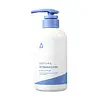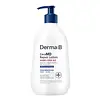What's inside
What's inside
 Key Ingredients
Key Ingredients

 Benefits
Benefits

 Concerns
Concerns

 Ingredients Side-by-side
Ingredients Side-by-side

Water
Skin ConditioningButylene Glycol
HumectantGlycerin
HumectantPropanediol
SolventPentaerythrityl Tetraethylhexanoate
EmollientHydrogenated Poly(C6-14 Olefin)
Emollient1,2-Hexanediol
Skin ConditioningPhenyl Trimethicone
Skin ConditioningBis-Hydroxyethoxypropyl Dimethicone
EmollientSynthetic Wax
AbrasiveC14-22 Alcohols
Emulsion StabilisingSqualane
EmollientCetearyl Alcohol
EmollientHydroxypropyl Starch Phosphate
Xanthan Gum
EmulsifyingGlyceryl Stearate
EmollientHydrogenated Lecithin
EmulsifyingAcrylates/C10-30 Alkyl Acrylate Crosspolymer
Emulsion StabilisingC12-20 Alkyl Glucoside
EmulsifyingAcetyl Glucosamine
Skin ConditioningStearic Acid
CleansingGlyceryl Stearate Citrate
EmollientHydrogenated Vegetable Oil
EmollientGlyceryl Caprylate
EmollientTromethamine
BufferingPanthenol
Skin ConditioningPolyglyceryl-10 Stearate
Skin ConditioningPalmitic Acid
EmollientEthylhexylglycerin
Skin ConditioningDisodium EDTA
Gluconolactone
Skin ConditioningPolyglyceryl-3 Methylglucose Distearate
EmulsifyingCarbomer
Emulsion StabilisingThymol Trimethoxycinnamate
AntioxidantCholesterol
EmollientCeramide NP
Skin ConditioningGlucose
HumectantOenothera Biennis Oil
EmollientHydroxypropyl Bispalmitamide Mea
EmollientMannitol
HumectantMyristic Acid
CleansingLauric Acid
CleansingTocopherol
AntioxidantCopernicia Cerifera Wax Extract
Acrylates/Ammonium Methacrylate Copolymer
Silica
AbrasiveArachidic Acid
CleansingCaesalpinia Sappan Stem Powder
ExfoliatingOleic Acid
EmollientWater, Butylene Glycol, Glycerin, Propanediol, Pentaerythrityl Tetraethylhexanoate, Hydrogenated Poly(C6-14 Olefin), 1,2-Hexanediol, Phenyl Trimethicone, Bis-Hydroxyethoxypropyl Dimethicone, Synthetic Wax, C14-22 Alcohols, Squalane, Cetearyl Alcohol, Hydroxypropyl Starch Phosphate, Xanthan Gum, Glyceryl Stearate, Hydrogenated Lecithin, Acrylates/C10-30 Alkyl Acrylate Crosspolymer, C12-20 Alkyl Glucoside, Acetyl Glucosamine, Stearic Acid, Glyceryl Stearate Citrate, Hydrogenated Vegetable Oil, Glyceryl Caprylate, Tromethamine, Panthenol, Polyglyceryl-10 Stearate, Palmitic Acid, Ethylhexylglycerin, Disodium EDTA, Gluconolactone, Polyglyceryl-3 Methylglucose Distearate, Carbomer, Thymol Trimethoxycinnamate, Cholesterol, Ceramide NP, Glucose, Oenothera Biennis Oil, Hydroxypropyl Bispalmitamide Mea, Mannitol, Myristic Acid, Lauric Acid, Tocopherol, Copernicia Cerifera Wax Extract, Acrylates/Ammonium Methacrylate Copolymer, Silica, Arachidic Acid, Caesalpinia Sappan Stem Powder, Oleic Acid
Water
Skin ConditioningButylene Glycol
HumectantGlycerin
HumectantCaprylic/Capric Triglyceride
MaskingPropanediol
SolventCetearyl Alcohol
EmollientHydrogenated Vegetable Oil
EmollientHydrogenated Polyisobutene
EmollientGlyceryl Stearate
EmollientVinyldimethicone
Ceramide NP
Skin ConditioningPanthenol
Skin ConditioningPolyglyceryl-10 Distearate
EmulsifyingSorbitan Stearate
EmulsifyingLimnanthes Alba Seed Oil
Skin ConditioningPhytosteryl/Isostearyl/Cetyl/Stearyl/Behenyl Dimer Dilinoleate
Skin ConditioningAllantoin
Skin ConditioningHydroxypropyl Methylcellulose
Emulsion StabilisingPotassium Cetyl Phosphate
EmulsifyingDipotassium Glycyrrhizate
HumectantPhenethyl Alcohol
MaskingSodium Hyaluronate
HumectantMethylbenzyl Methylbenzimidazole Piperidinylmethanone
Hydrogenated Lecithin
EmulsifyingOlea Europaea Fruit Oil
MaskingButyrospermum Parkii Butter
Skin ConditioningVitis Vinifera Seed Oil
EmollientCandida Bombicola/Glucose/Methyl Rapeseedate Ferment
AntimicrobialGlycolipids
Skin ConditioningArginine
MaskingCarbomer
Emulsion Stabilising1,2-Hexanediol
Skin ConditioningStearic Acid
CleansingCaprylyl Glycol
EmollientWater, Butylene Glycol, Glycerin, Caprylic/Capric Triglyceride, Propanediol, Cetearyl Alcohol, Hydrogenated Vegetable Oil, Hydrogenated Polyisobutene, Glyceryl Stearate, Vinyldimethicone, Ceramide NP, Panthenol, Polyglyceryl-10 Distearate, Sorbitan Stearate, Limnanthes Alba Seed Oil, Phytosteryl/Isostearyl/Cetyl/Stearyl/Behenyl Dimer Dilinoleate, Allantoin, Hydroxypropyl Methylcellulose, Potassium Cetyl Phosphate, Dipotassium Glycyrrhizate, Phenethyl Alcohol, Sodium Hyaluronate, Methylbenzyl Methylbenzimidazole Piperidinylmethanone, Hydrogenated Lecithin, Olea Europaea Fruit Oil, Butyrospermum Parkii Butter, Vitis Vinifera Seed Oil, Candida Bombicola/Glucose/Methyl Rapeseedate Ferment, Glycolipids, Arginine, Carbomer, 1,2-Hexanediol, Stearic Acid, Caprylyl Glycol
 Reviews
Reviews

Ingredients Explained
These ingredients are found in both products.
Ingredients higher up in an ingredient list are typically present in a larger amount.
1,2-Hexanediol is a synthetic liquid and another multi-functional powerhouse.
It is a:
- Humectant, drawing moisture into the skin
- Emollient, helping to soften skin
- Solvent, dispersing and stabilizing formulas
- Preservative booster, enhancing the antimicrobial activity of other preservatives
Butylene Glycol (or BG) is used within cosmetic products for a few different reasons:
Overall, Butylene Glycol is a safe and well-rounded ingredient that works well with other ingredients.
Though this ingredient works well with most skin types, some people with sensitive skin may experience a reaction such as allergic rashes, closed comedones, or itchiness.
Learn more about Butylene GlycolCarbomer is a polymer of acrylic acid. Its main role is to create a gel consistency.
A high amount of carbomer can cause pilling or balling up of products. Don't worry, most products contain 1% or less of carbomer.
Ceramide NP is a type of ceramide.
Ceramides are intercellular lipids naturally found in our skin that bonds dead skin cells together to create a barrier. They are known for their ability to hold water and thus are a great ingredient for dry skin.
Ceramides are an important building block for our skin barrier. A stronger barrier helps the skin look more firm and hydrated. By bolstering the skin ceramides act as a barrier against irritating ingredients. This can help with inflammation as well.
If you would like to eat ceramides, sweet potatoes contain a small amount.
Read more about other common types of ceramides here:
Ceramide AP
Ceramide EOP
Cetearyl alcohol is a mixture of two fatty alcohols: cetyl alcohol and stearyl alcohol. It is mainly used as an emulsifier. Emulsifiers help prevent the separation of oils and products. Due to its composition, it can also be used to thicken a product or help create foam.
Cetearyl alcohol is an emollient. Emollients help soothe and hydrate the skin by trapping moisture.
Studies show Cetearyl alcohol is non-toxic and non-irritating. The FDA allows products labeled "alcohol-free" to have fatty alcohols.
This ingredient is usually derived from plant oils such as palm, vegetable, or coconut oils. There is debate on whether this ingredient will cause acne.
Due to the fatty acid base, this ingredient may not be Malassezia folliculitis safe.
Learn more about Cetearyl AlcoholGlycerin is already naturally found in your skin. It helps moisturize and protect your skin.
A study from 2016 found glycerin to be more effective as a humectant than AHAs and hyaluronic acid.
As a humectant, it helps the skin stay hydrated by pulling moisture to your skin. The low molecular weight of glycerin allows it to pull moisture into the deeper layers of your skin.
Hydrated skin improves your skin barrier; Your skin barrier helps protect against irritants and bacteria.
Glycerin has also been found to have antimicrobial and antiviral properties. Due to these properties, glycerin is often used in wound and burn treatments.
In cosmetics, glycerin is usually derived from plants such as soybean or palm. However, it can also be sourced from animals, such as tallow or animal fat.
This ingredient is organic, colorless, odorless, and non-toxic.
Glycerin is the name for this ingredient in American English. British English uses Glycerol/Glycerine.
Learn more about GlycerinGlyceryl Stearate is a mix of glycerin and stearic acid.
It is used to stabilize the mixing of water and oil ingredients. By preventing these ingredients from separating, it can help elongate shelf life. It can also help thicken the product's texture.
As an emollient, it helps soften skin and supports barrier-replenishing ingredients.
In cosmetics, Glyceryl Stearate is often made from vegetable oils or synthetically produced.
This ingredient may not be fungal-acne safe
Fun fact: The human body also creates Glyceryl Stearate naturally.
Learn more about Glyceryl StearateHydrogenated Lecithin is created from the hydrogenation of lecithin (a group of phospholipids). Hydrogenation is a chemical reaction between hydrogen and another element.
This ingredient is an emollient and emulsifier. As an emollient, it helps soften skin by trapping moisture within. As an emulsifier, it prevents oil and water ingredients from separating.
Hydrogenated Vegetable Oil is created by adding hydrogen to vegetable oil in order to give it more stability. This process also raises the melting point of vegetable oil. In cosmetics, it is an emollient.
Emollients help soothe and soften the skin. They do this by creating a protective film on your skin. This barrier helps trap moisture and keeps your skin hydrated. Emollients may be effective at treating dry or itchy skin.
The term "Hydrogenated Vegetable Oil" is an umbrella term and can refer to a variety of vegetable oils and blends of: sunflower oil, soybean oil, olive oil, coconut oil, palm oil, and more.
Due to the differences in vegetables, the benefits may vary.
Learn more about Hydrogenated Vegetable OilPanthenol is a common ingredient that helps hydrate and soothe the skin. It is found naturally in our skin and hair.
There are two forms of panthenol: D and L.
D-panthenol is also known as dexpanthenol. Most cosmetics use dexpanthenol or a mixture of D and L-panthenol.
Panthenol is famous due to its ability to go deeper into the skin's layers. Using this ingredient has numerous pros (and no cons):
Like hyaluronic acid, panthenol is a humectant. Humectants are able to bind and hold large amounts of water to keep skin hydrated.
This ingredient works well for wound healing. It works by increasing tissue in the wound and helps close open wounds.
Once oxidized, panthenol converts to pantothenic acid. Panthothenic acid is found in all living cells.
This ingredient is also referred to as pro-vitamin B5.
Learn more about PanthenolPropanediol is an all-star ingredient. It softens, hydrates, and smooths the skin.
It’s often used to:
Propanediol is not likely to cause sensitivity and considered safe to use. It is derived from corn or petroleum with a clear color and no scent.
Learn more about PropanediolStearic Acid is a fatty acid. It is an emollient, emulsifier, and texture enhancer.
As an emollient, stearic acid helps soften skin. It aids the skin's protective barrier by preventing water loss. It also provides a gentle cleansing effect without stripping away natural oils.
Stearic acid may also be used to enhance the texture of products. It can add volume and stabilize ingredients such as water and oil. This can help water and oil ingredients from separating.
Sources of stearic acid include animal or vegetable fats/oils such as coconut or shea. It can be naturally found in butter, cocoa butter, shea butter, vegetable fats, and animal tallow.
This ingredient may not be Malassezia folliculitis, or fungal-acne safe.
Learn more about Stearic AcidWater. It's the most common cosmetic ingredient of all. You'll usually see it at the top of ingredient lists, meaning that it makes up the largest part of the product.
So why is it so popular? Water most often acts as a solvent - this means that it helps dissolve other ingredients into the formulation.
You'll also recognize water as that liquid we all need to stay alive. If you see this, drink a glass of water. Stay hydrated!
Learn more about Water